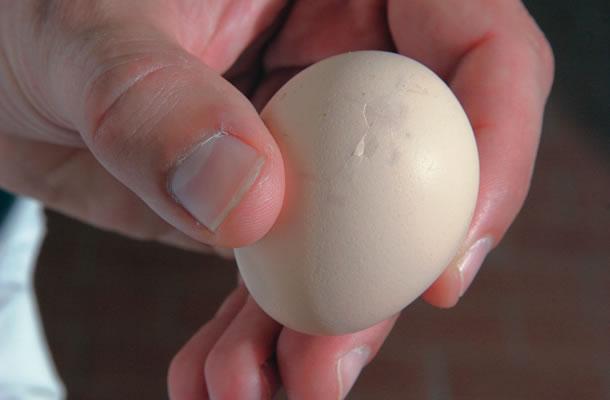Impact of hairline-cracked eggs
Tags: Hatching | Whitepaper
, 21 September 2010

In general, good quality eggs are selected and placed for incubation. This means that only clean eggs with shell intact should be placed on the setter trays. Dirty or floor eggs and eggs with visible cracks are removed and not placed. Eggs with hairline cracks might often not be recognised and will, consequently, be placed in the setter trays and incubated.
In cracked eggs, the shell is broken and the underlying membrane is ruptured - leading to dehydration and the death of the embryo. However eggs with undamaged membranes but broken shells are defined as having hairline cracks - and these are often placed because unless candled, they look like good quality eggs.
A study of the incubation of good quality hatching eggs versus those with hairline cracks produced the results shown in the summary. In this experiment, eggs from five commercial flocks of various strains were candled and an equal number of hairline-cracked and normal eggs were incubated for 21 days. Eggs were identified as having a hairline crack if the crack was visible by candling, but not apparent when examined normally.
The study concludes
- Setting eggs with hairline-cracks significantly reduces hatchability.
- Chicks hatched from hairline-cracked eggs demonstrate higher mortality during a 14 day growing period.
- Egg weight loss during the setting period increases significantly in hairline-cracked eggs, producing smaller chicks as a consequence. This however has no effect on day 14 weight.
- Compared to good quality eggs, a significantly higher incidence of contaminated and broken eggs was found after incubating eggs with hairline-cracks.
Advice
- Do not set hairline-cracked eggs.
- Candle egg samples from batches transported to the hatchery on a regular basis to evaluate the incidence of hairline-cracked eggs.
- Record the number of eggs with hairline-cracks.
- If the frequency of hairline-cracked eggs is unsatisfactory, investigate and eliminate possible causes.
- Avoid the use of plastic trays with sharp edges for the transportation of eggs, as these are likely to be a major cause of hairline-cracks.
| Good quality eggs | Hairline-cracked eggs | ||
| Hatchability % | |||
| - Eggs set | 74.4 | 50.5 | Significant (P < 0.05) |
| - Fertile eggs | 80.9 | 56.4 | Significant (P < 0.05)) |
| Chick weight | |||
| - Weight (g) | 45.0 | 43.5 | Significant (P < 0.05) |
| - Relative weight (% of eggs set) | 69.9 | 67.5 | Significant (P < 0.05) |
| Growth performance | |||
| - D14 body weight | 293.5 | 298.9 | Not significant |
| - Mortality | 2 | 7.5 | Significant (P < 0.05) |
| Egg weight loss in the setter (%) | 13.4 | 17.02 | Significant (P < 0.05) |
| Embryonic mortality (%) | |||
| - Early (1 - 7d) | 7.9 | 13.9 | Not significant |
| - Mid (8 - 14d) | 0.0 | 2.9 | Significant (P < 0.05) |
| - Late (15 - 21d) | 4.6 | 15.5 | Significant (P < 0.05) |
| - Cull | 5.3 | 6.2 | Not significant |
| Contaminated or broken (%) | 1.2 | 5.2 | Significant (P < 0.05) |
Reference: Barnet et al. (2004). Hatchability and Early Chick Growth: potential of broiler breeder eggs with hairline cracks. J. Appl. Poult Res. 13: 65 - 70.
Written by Dr. Marleen Boerjan
We welcome your feedback on this article - and if you require any additional information, please don't hesitate to contact Pas Reform Academy.